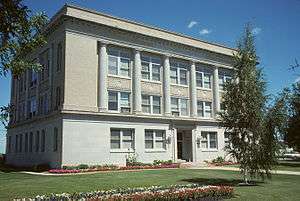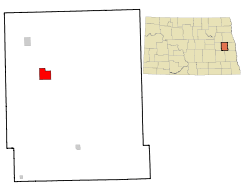Finley, North Dakota
Finley is a city in Steele County, North Dakota, United States. It is the county seat of Steele County.[5] The population was 445 at the 2010 census.[6] Finley was founded in 1897.
Finley, North Dakota | |
|---|---|
 Steele County Courthouse in Finley | |
 Location of Finley, North Dakota | |
| Coordinates: 47°30′46″N 97°50′13″W | |
| Country | United States |
| State | North Dakota |
| County | Steele |
| Area | |
| • Total | 3.49 sq mi (9.03 km2) |
| • Land | 3.49 sq mi (9.03 km2) |
| • Water | 0.00 sq mi (0.00 km2) |
| Elevation | 1,453 ft (443 m) |
| Population | |
| • Total | 445 |
| • Estimate (2019)[3] | 416 |
| • Density | 119.30/sq mi (46.07/km2) |
| Time zone | UTC-6 (Central (CST)) |
| • Summer (DST) | UTC-5 (CDT) |
| ZIP code | 58230 |
| Area code(s) | 701 |
| FIPS code | 38-26420 |
| GNIS feature ID | 1028959[4] |
| Website | http://finleynd.com/ |
History
Finley was founded in 1897. In 1919, the county seat was transferred to Finley from Sherbrooke, North Dakota.[7]
Geography
Finley is located at 47°30′46″N 97°50′13″W (47.512779, -97.836957).[8]
According to the United States Census Bureau, the city has a total area of 3.47 square miles (8.99 km2), all of it land.[9]
Demographics
| Historical population | |||
|---|---|---|---|
| Census | Pop. | %± | |
| 1910 | 516 | — | |
| 1920 | 599 | 16.1% | |
| 1930 | 587 | −2.0% | |
| 1940 | 677 | 15.3% | |
| 1950 | 671 | −0.9% | |
| 1960 | 808 | 20.4% | |
| 1970 | 809 | 0.1% | |
| 1980 | 718 | −11.2% | |
| 1990 | 543 | −24.4% | |
| 2000 | 515 | −5.2% | |
| 2010 | 445 | −13.6% | |
| Est. 2019 | 416 | [3] | −6.5% |
| U.S. Decennial Census[10] 2018 Estimate[11] | |||
2010 census
At the 2010 census there were 445 people in 206 households, including 125 families, in the city. The population density was 128.2 inhabitants per square mile (49.5/km2). There were 245 housing units at an average density of 70.6 per square mile (27.3/km2). The racial makup of the city was 95.7% White, 0.2% African American, 2.2% Native American, 0.7% from other races, and 1.1% from two or more races. Hispanic or Latino of any race were 0.7%.[2]
Of the 206 households 25.7% had children under the age of 18 living with them, 49.0% were married couples living together, 5.8% had a female householder with no husband present, 5.8% had a male householder with no wife present, and 39.3% were non-families. 32.5% of households were one person and 19.9% were one person aged 65 or older. The average household size was 2.16 and the average family size was 2.67.
The median age was 45.9 years. 21.1% of residents were under the age of 18; 5.6% were between the ages of 18 and 24; 22.2% were from 25 to 44; 27.1% were from 45 to 64; and 23.8% were 65 or older. The gender makeup of the city was 49.4% male and 50.6% female.
2000 census
At the 2000 census, there were 515 people in 224 households, including 144 families, in the city. The population density was 147.4 people per square mile (57.0/km2). There were 256 housing units at an average density of 73.3 per square mile (28.3/km2). The racial makup of the city was 97.28% White, 1.75% Native American, 0.39% from other races, and 0.58% from two or more races. Hispanic or Latino of any race were 0.19% of the population.
Of the 224 households 28.1% had children under the age of 18 living with them, 54.9% were married couples living together, 8.0% had a female householder with no husband present, and 35.7% were non-families. 32.6% of households were one person and 18.3% were one person aged 65 or older. The average household size was 2.30 and the average family size was 2.95.
The age distribution was 26.0% under the age of 18, 6.4% from 18 to 24, 19.2% from 25 to 44, 23.9% from 45 to 64, and 24.5% 65 or older. The median age was 43 years. For every 100 females, there were 95.8 males. For every 100 females age 18 and over, there were 89.6 males.
The median household income was $32,917 and the median family income was $43,417. Males had a median income of $34,844 versus $17,500 for females. The per capita income for the city was $17,989. About 10.1% of families and 10.7% of the population were below the poverty line, including 18.4% of those under age 18 and 3.7% of those age 65 or over.
References
- "2019 U.S. Gazetteer Files". United States Census Bureau. Retrieved July 27, 2020.
- "U.S. Census website". United States Census Bureau. Retrieved 2012-06-14.
- "Population and Housing Unit Estimates". United States Census Bureau. May 24, 2020. Retrieved May 27, 2020.
- "US Board on Geographic Names". United States Geological Survey. 2007-10-25. Retrieved 2008-01-31.
- "Find a County". National Association of Counties. Archived from the original on 2011-05-31. Retrieved 2011-06-07.
- "2010 Census Redistricting Data (Public Law 94-171) Summary File". American FactFinder. United States Census Bureau. Retrieved 2 May 2011.
- Hellmann, Paul T. (May 13, 2013). Historical Gazetteer of the United States. Routledge. p. 836. Retrieved 30 November 2013.
- "US Gazetteer files: 2010, 2000, and 1990". United States Census Bureau. 2011-02-12. Retrieved 2011-04-23.
- "US Gazetteer files 2010". United States Census Bureau. Archived from the original on 2012-01-25. Retrieved 2012-06-14.
- United States Census Bureau. "Census of Population and Housing". Retrieved January 19, 2014.
- "Population Estimates". United States Census Bureau. Retrieved June 16, 2019.
